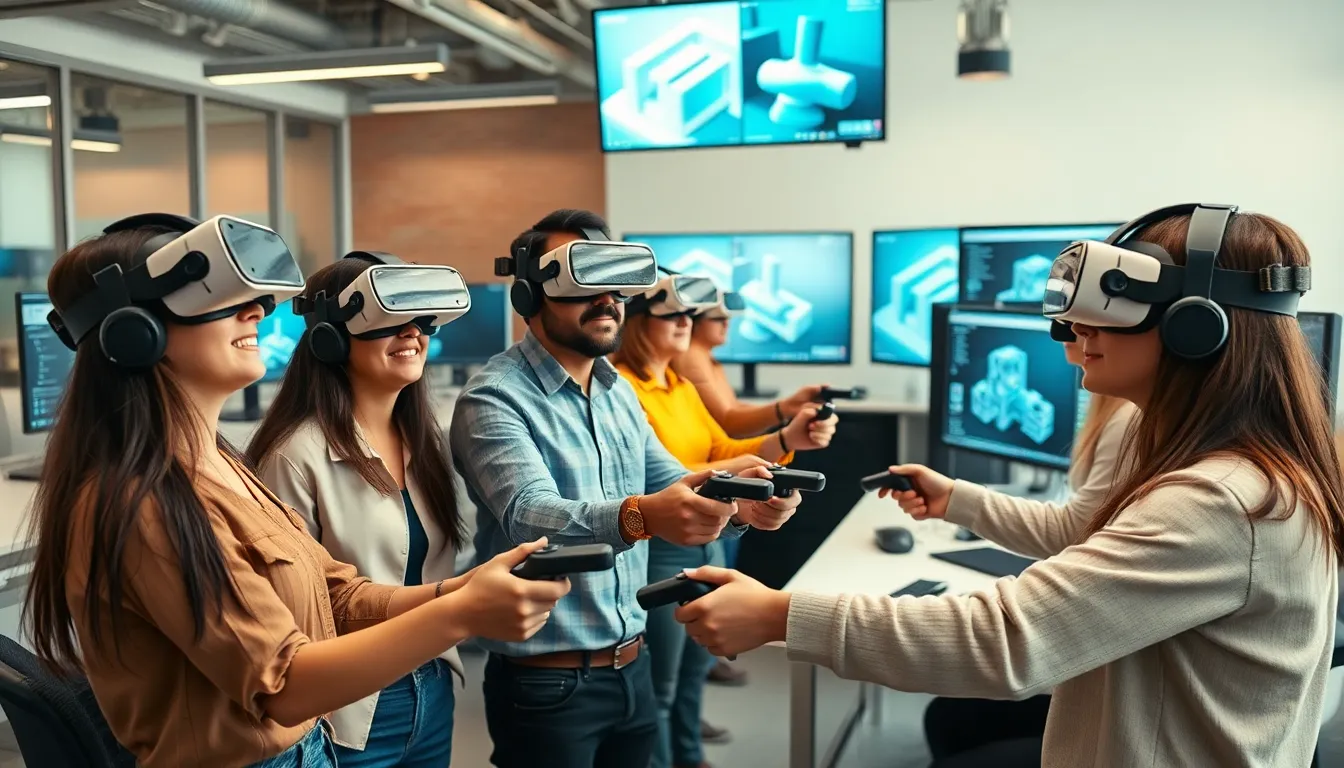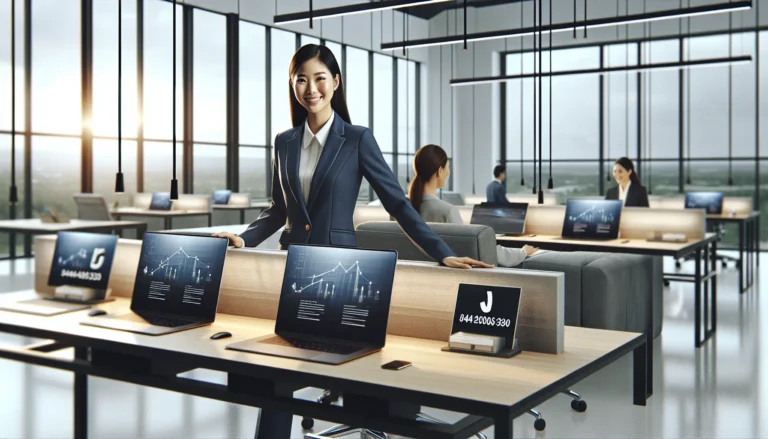Table of Contents
ToggleIn a world where reality can sometimes feel a bit too real, virtual reality workflows are here to save the day—or at least make it a lot more interesting. Imagine designing, collaborating, and creating in a space where the only limit is your imagination. Gone are the days of tedious back-and-forth emails and endless meetings. With VR, teams can dive into immersive environments that spark creativity and boost productivity.
Whether you’re an architect crafting the next skyscraper or a game developer conjuring fantastical worlds, virtual reality workflows offer a fresh approach to tackling projects. It’s like having a magic wand that turns ideas into 3D experiences, making collaboration not just effective but downright fun. So buckle up and get ready to explore how these innovative workflows can transform the way we work—because who wouldn’t want to swap a conference room for a virtual beach?
Understanding Virtual Reality Workflows
Virtual reality workflows represent a dynamic approach to create, communicate, and collaborate in immersive environments. These workflows streamline processes and enhance the overall work experience.
Definition of Virtual Reality Workflows
Virtual reality workflows consist of a series of steps and tools designed to utilize VR technology for project completion. These steps include concept development, immersive design, and team collaboration in virtual environments. Professionals can manipulate 3D models, conduct real-time reviews, and receive feedback instantaneously. Integrating VR into standard operating procedures transforms traditional tasks into engaging experiences, promoting creativity and innovation.
Importance in Various Industries
Virtual reality workflows significantly impact diverse sectors, including architecture, healthcare, and entertainment. In architecture, VR allows architects to visualize spaces before construction, improving design accuracy. Healthcare professionals use VR for surgical simulations, enhancing training outcomes and patient safety. In entertainment, game developers create immersive experiences, drawing players deeper into interactive worlds. Each industry benefits from improved collaboration, faster project delivery, and increased stakeholder satisfaction. Data demonstrates that adopting VR can lead to a 30% reduction in project timelines across multiple fields, showcasing its efficiency and effectiveness.
Key Components of Virtual Reality Workflows

Virtual reality workflows rely on specific hardware and software elements to function effectively. Each component plays a crucial role in delivering an immersive experience to users.
Hardware Requirements
Key hardware elements include VR headsets, motion controllers, and powerful computers. VR headsets provide the immersive visuals required for realistic environments. Motion controllers enable intuitive interactions with virtual objects, allowing users to engage naturally. High-performance computers deliver the necessary processing power, ensuring smooth graphics and quick load times. It’s essential for users to meet recommended specifications for optimal performance, which often includes having at least 16 GB of RAM and a dedicated graphics card.
Software Solutions
Various software solutions support VR workflows, facilitating design and collaboration. 3D modeling tools help create detailed virtual environments. Platforms such as Unity or Unreal Engine enable developers to build interactive experiences. Collaboration software like Spatial allows teams to meet and brainstorm in shared virtual spaces. Document management systems streamline sharing project assets and feedback, enhancing overall productivity and engagement. Virtual reality workflows integrate these software solutions to transform how teams collaborate and innovate.
Implementation Strategies
Implementing virtual reality workflows requires strategic planning and careful execution. Focusing on design and training ensures successful integration.
Designing Effective Workflows
Designing effective virtual reality workflows revolves around clarity and adaptability. Identify specific project goals and tailor the workflow to meet unique requirements. Streamlining steps enhances usability and engagement. Include phase checkpoints for feedback to improve outcomes. Collaboration tools must align with the workflow, enabling instant communication among team members. Tools like Unity or Unreal Engine can augment design, allowing rapid prototyping and iteration. Continuous assessment of the workflow promotes efficiency and keeps the team’s focus on objectives.
Training and Support
Training and support play vital roles in the successful implementation of virtual reality workflows. Providing comprehensive training ensures that team members can navigate new technologies confidently. Structured workshops and hands-on sessions facilitate skill acquisition. Ongoing support, through resources such as tutorials and mentorship, reinforces learning. Establishing a feedback loop aids in addressing user concerns promptly. Encouraging a culture of experimentation allows teams to fully explore VR capabilities. This approach cultivates innovation and enhances overall productivity.
Challenges in Virtual Reality Workflows
Virtual reality workflows face several challenges that can hinder their implementation and effectiveness. Addressing these obstacles contributes to smoother operations and better outcomes.
Technical Limitations
Technical limitations pose a significant challenge in virtual reality workflows. Hardware requirements such as high-performance computers and advanced VR headsets can be costly and difficult to acquire. Inadequate technical capabilities result in subpar experiences, which can deter users from fully engaging with the technology. Compatibility issues among software and hardware can interrupt workflow continuity, affecting team collaboration. Moreover, latency issues impact real-time feedback, creating frustration during immersive experiences. Effective planning and investment in suitable technology help mitigate these technical challenges.
User Adoption Issues
User adoption issues frequently arise when integrating VR workflows. Individuals may resist adopting new technologies due to unfamiliarity or discomfort. Training programs that lack structure can make users feel overwhelmed, further deterring engagement with VR. Resistance to change often stems from a fear of disrupting established routines and practices, especially in team environments. Encouraging participation in workshops and ongoing support can foster a sense of comfort and familiarity with virtual reality. Cultivating a positive attitude toward experimentation enhances user acceptance and promotes productive collaboration within teams.
Future Trends in Virtual Reality Workflows
Future trends in virtual reality workflows promise significant advancements across various sectors. Innovations in immersive technology continue to redefine how teams collaborate and create.
Innovations on the Horizon
Emerging tools enhance user experience through improved visuals and interactivity. Advancements in artificial intelligence contribute to smarter environments where VR can adapt to user preferences. New hardware developments make VR more accessible and efficient. Companies are also exploring augmented reality integration within VR workflows, providing enriched layers of information during projects. This approach leads to better decision-making, as users can visualize changes in real-time. Lastly, increased cloud computing capabilities enable remote teams to access VR projects more seamlessly.
Potential Impact on Industries
Virtual reality workflows are set to revolutionize industries such as education, healthcare, and manufacturing. In education, VR creates immersive learning experiences that engage students more effectively. Medical professionals use VR for enhanced training and surgical simulations, reducing risks during real procedures. Manufacturing sectors benefit from virtual prototyping that shortens product development cycles. Architects visualize structures in realistic environments before construction starts, improving planning accuracy. Game development experiences deeper player engagement through lifelike interactions. As industries continue to adopt VR workflows, efficiency and creativity see substantial boosts, making it a game-changer across the board.
Virtual reality workflows represent a significant leap forward in how professionals approach their projects. By embracing VR technology, teams can unlock new levels of creativity and collaboration that traditional methods simply can’t match. The ability to visualize concepts in immersive environments fosters innovation and streamlines processes across various industries.
As organizations continue to explore and integrate these workflows, they’ll likely discover enhanced efficiency and productivity. The ongoing advancements in VR tools and techniques will further empower professionals to push boundaries and achieve remarkable results. Adopting VR is not just a trend; it’s a strategic move toward a more engaging and effective work experience.





